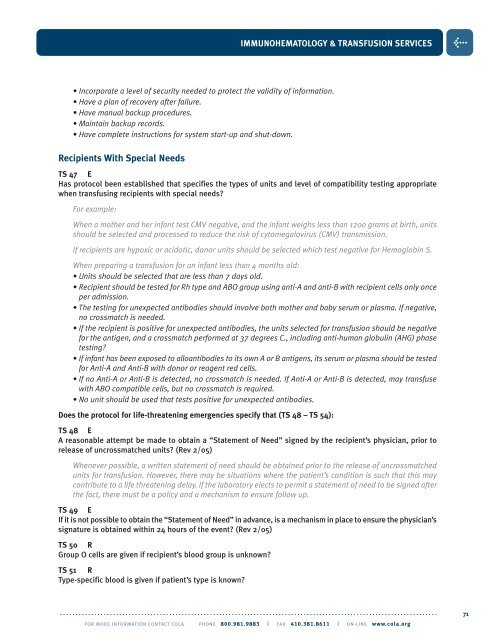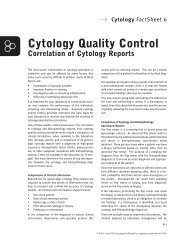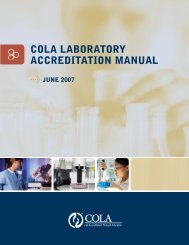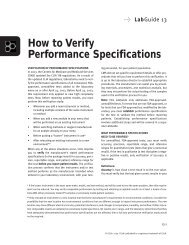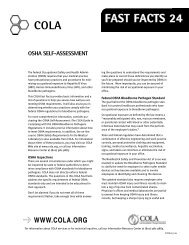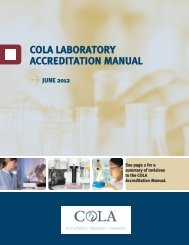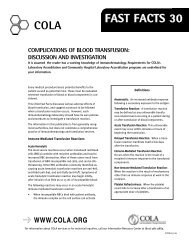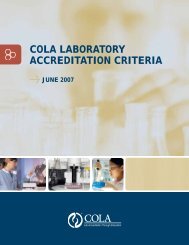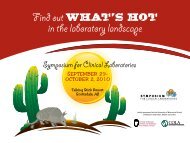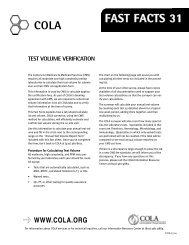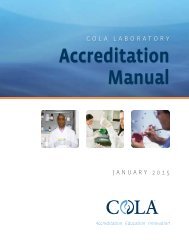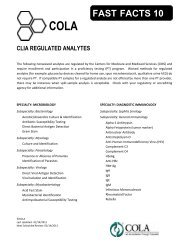#06-5558 Accrd Manual V7 - COLA
#06-5558 Accrd Manual V7 - COLA
#06-5558 Accrd Manual V7 - COLA
- No tags were found...
Create successful ePaper yourself
Turn your PDF publications into a flip-book with our unique Google optimized e-Paper software.
IMMUNOHEMATOLOGY & TRANSFUSION SERVICES>• Incorporate a level of security needed to protect the validity of information.• Have a plan of recovery after failure.• Have manual backup procedures.• Maintain backup records.• Have complete instructions for system start-up and shut-down.Recipients With Special NeedsTS 47 EHas protocol been established that specifies the types of units and level of compatibility testing appropriatewhen transfusing recipients with special needs?For example:When a mother and her infant test CMV negative, and the infant weighs less than 1200 grams at birth, unitsshould be selected and processed to reduce the risk of cytomegalovirus (CMV) transmission.If recipients are hypoxic or acidotic, donor units should be selected which test negative for Hemoglobin S.When preparing a transfusion for an infant less than 4 months old:• Units should be selected that are less than 7 days old.• Recipient should be tested for Rh type and ABO group using anti-A and anti-B with recipient cells only onceper admission.• The testing for unexpected antibodies should involve both mother and baby serum or plasma. If negative,no crossmatch is needed.• If the recipient is positive for unexpected antibodies, the units selected for transfusion should be negativefor the antigen, and a crossmatch performed at 37 degrees C., including anti-human globulin (AHG) phasetesting?• If infant has been exposed to alloantibodies to its own A or B antigens, its serum or plasma should be testedfor Anti-A and Anti-B with donor or reagent red cells.• If no Anti-A or Anti-B is detected, no crossmatch is needed. If Anti-A or Anti-B is detected, may transfusewith ABO compatible cells, but no crossmatch is required.• No unit should be used that tests positive for unexpected antibodies.Does the protocol for life-threatening emergencies specify that (TS 48 – TS 54):TS 48 EA reasonable attempt be made to obtain a “Statement of Need” signed by the recipient’s physician, prior torelease of uncrossmatched units? (Rev 2/05)Whenever possible, a written statement of need should be obtained prior to the release of uncrossmatchedunits for transfusion. However, there may be situations where the patient’s condition is such that this maycontribute to a life threatening delay. If the laboratory elects to permit a statement of need to be signed afterthe fact, there must be a policy and a mechanism to ensure follow up.TS 49 EIf it is not possible to obtain the “Statement of Need” in advance, is a mechanism in place to ensure the physician’ssignature is obtained within 24 hours of the event? (Rev 2/05)TS 50 RGroup O cells are given if recipient’s blood group is unknown?TS 51 RType-specific blood is given if patient’s type is known?. . . . . . . . . . . . . . . . . . . . . . . . . . . . . . . . . . . . . . . . . . . . . . . . . . . . . . . . . . . . . . . . . . . . . . . . . . . . . . . . . . . . . . . . . . . . . . . . . . . . . . . . . . . . . . . . . . . . . . . . .FOR MORE INFORMATION CONTACT <strong>COLA</strong> PHONE 800.981.9883 | FAX 410.381.8611 | ON-LINE www.cola.org71


